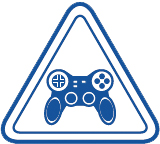
The Boy Scouts of America recently introduced a "Video Games" Belt Loop and Academic Pin that can be earned by those at the Cub Scout level. The requirements to earn it are pasted below the main story.
I'm an Eagle Scout, so I have a little bit of perspective here. First of all, this isn't a merit badge. Merit badges are more rigorous awards for Boy Scouts (middle and high-school kids) whereas this is a belt loop/academic pin, a non-essential award for Cub Scouts (elementary school kids). All belt loops and academic pins are extra recognition for activities not actually necessary to advance to the next rank. Other new belt loops included this year are "Reading and Writing," "Skateboarding," "Photography," and "Good Manners."
The award requirements below have a real emphasis on edutainment, understanding the ratings system, and basically every form of moderation one can have in video game play. One funny part: The 7th academic pin requirement asks that you play a video game that helps with your math, spelling, or any other part of your homework. Well, math and spelling are specifically the educational skills I think video games are worst at getting across, because they involve a lot more pure memorization and less understanding of a general system. History and science can actually use the procedural rhetoric of video games to be better than textbooks at educating, but that's for another article.
Belt Loop
Complete these three requirements:
- Explain why it is important to have a rating system for video games. Check your video games to be sure they are right for your age.
- With an adult, create a schedule for you to do things that includes your chores, homework, and video gaming. Do your best to follow this schedule.
- Learn to play a new video game that is approved by your parent, guardian, or teacher.
Academics Pin
Earn the Video Games belt loop and complete five of the following requirements:
- With your parents, create a plan to buy a video game that is right for your age group.
- Compare two game systems (for example, Microsoft Xbox, Sony PlayStation, Nintendo Wii, and so on). Explain some of the differences between the two. List good reasons to purchase or use a game system.
- Play a video game with family members in a family tournament.
- Teach an adult or a friend how to play a video game.
- List at least five tips that would help someone who was learning how to play your favorite video game.
- Play an appropriate video game with a friend for one hour.
- Play a video game that will help you practice your math, spelling, or another skill that helps you in your schoolwork.
- Choose a game you might like to purchase. Compare the price for this game at three different stores. Decide which store has the best deal. In your decision, be sure to consider things like the store return policy and manufacturer’s warranty.
- With an adult’s supervision, install a gaming system.